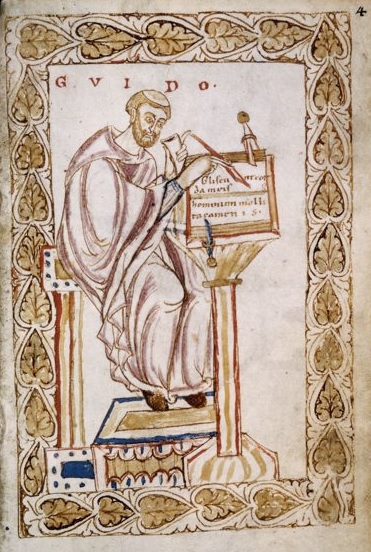中世紀的音樂理論和實踐
加洛林王朝時代Carolingian和中世紀晚期的專題論文比早期的著作更加著重實踐方面。 波伊提烏Carolingian經常被人尊敬地提及,而且他傳下來的音樂的數學基本理論,一直還是音階scale構成、考察音程intervals和協和音consonances的基礎。但是,閱讀波伊提烏的著作並不能解決一些迫切的問題,如素歌的記譜、閱讀、分類和演唱,以及早期復調音樂polyphony的即興表演和創作。這些問題現在卻成為中世紀論文的焦點。例如,規多•達雷佐(Guido of Arezzo 約991 1033)的《辨及微芒》(Micrologus 約1025—1028)中,就把音程數值比率的闡釋歸功於波伊提烏。規多講述了畢達哥拉斯在鐵匠鋪聽到錘子的聲音而發現這些關係的故事。於是,規多采用這些比率ratios,並用波伊提烏的方法在測弦器monochord上劃分。(測弦器就是一根弦繃在一個長長的木質共鳴箱上,用一個活動的琴橋來改變弦的發聲長度。)但是,在知道了波伊提烏的設計後,規多提出一個更簡單的方法,也能發出同樣的自然音階。按9:8的比例,也能產生純四度和純五度,以及八度octaves和一個單獨的全音。規多還脫離了希臘的理論,建立一種不以四音列tetrachord為基礎的音階scale,並論證了一套同古代托諾斯tonoi或哈莫尼亞harmoniai都無關聯的調式。他費盡心機地教導學生懂得這些調式的特點和性能,並指出如何根據它們創造旋律,以及如何把兩個以上的聲部結合起來同時詠唱。規多在9世紀一部供名的專論《音樂手冊》Musica enchiriadis中還發現了“迪阿風”(diaphony,原意為“不協和”,中世紀理論家用它來指奧爾加農—譯注)或奧爾加農organum的一些範例。
像《音樂手冊》這樣的專題論文,再加上與之相伴的記錄師生對話的《學習手冊》,都是用來指導有志於神職工作的學生們的。修道院和附屬於大教堂的學校,既是宗教團體又是教育機構。
在修道院中,音樂訓練是實用性的,還有些零散的初級水平的非音樂課程。大教堂附設的學校更重視思辨性問題的學習,從13世紀開始,這些學校主要都是為大學輸送學生。但是,中世紀時代的正規教育主要是面向實用性的事物,在音樂論文中也反映了這種態度。這些論文的作者都是在一兩章的緒論中向波伊提烏表示敬意之後,便如釋重負般地轉向更為緊迫的論題。有些訓練手冊是用韻文寫的,其他的是急於學習的學生和無所不知的教師之間的對話體,反映了慣用的口授教育方法十分強調記憶。利用圖表等直觀方法的幫助,教師教學生唱音程、背聖詠,然後又教他們視唱。到了後來,教程中一個最重要的部分就是八個調式(modes,也被中世紀作者稱為toni)系統。
【文本來源:Donald Jay Grout_ Claude Victor Palisca- 西方音乐史-人民音乐出版社(2010)(第六版) 第44-45頁】
MEDIEVAL MUSIC THEORY AND PRACTICE
Treatises in the Carolingian era and in the later Middle Ages were much more oriented toward practice than earlier writings were. Carolingian was regularly mentioned with reverence, and the mathematical fundamentals of music that he transmitted remained at the root of scale building and speculation about intervals and consonances. But reading Boethius did not help solve the immediate problems of notating, reading, classifying, and singing plainchant and of improvising or composing early polyphony. These topics now dominated the treatises.
In his Micrologus (ca. 1025-28), for example, Guido of Arezzo (ca. 991-after 1033) credits Boethius with explaining the numerical ratios of the intervals. Guido recounts the story that Pythagoras discovered these relationships while hearing the hammers in a blacksmith shop. Guido then takes these ratios and divides a monochord in the manner of Bothius. (The monochord was a string stretched over a long wooden resonator, with a movable bridge to vary the sounding length of the string.) However, after reporting Boethius's scheme, Guido presents a simpler method that yields the same diatonic scale, tuned to produce pure fourths and fifths as well as octaves and a single size of whole tone, in the ratio 9:8. Guido also departs from Greek theory by constructing a scale that is not based on the tetrachord and by demonstrating a set of modes that have no connection with the tonoi or harmoniai of the ancients. He takes great pains to instruct the student in the characteristics and power of the modes and shows how to invent melodies based on them and how to combine two or more voices in simultaneous chanting. Guido found some models for this diaphony or organum in an anonymous ninth-century treatise known as Musica enchiriadis.
Treatises such as Musica enchiriadis and even more the accompanying Scolica enchiriadis, a dialogue between teacher and pupil were directed at students who aspired to enter clerical orders. The monasteries and the schools attached to cathedral churches were educational as well as religious institutions.
In the monasteries, musical instruction was practical, with a scattering of nonmusical subjects at an elementary level. The cathedral schools gave more attention to speculative studies, and, from the beginning of the thirteenth century, it was chiefly these schools that prepared students for the universities. But formal education in medieval times was mainly oriented toward practical matters, and the musical treatises reflect this attitude. Their authors pay their respects to Boethius in an introductory chapter or two and then turn, with evident relief, to more pressing topics. Some of the instruction books are in verse; others are written as dialogues between an eager student and an omniscient master, reflecting the customary oral method of teaching with great emphasis on memorization. Visual aids appeared in the shape of diagrams and tables. Students were taught to sing intervals, to memorize chants, and, later, to read notes at sight. Toward these ends, one of the most essential components of the curriculum was the system of eight modes, or toni (tones), as medieval writers called them.
[Source: Donald Jay Grout_ Claude V. Palisca - A history of western music-6th Edition - Norton (2001),pp. 50-52]
